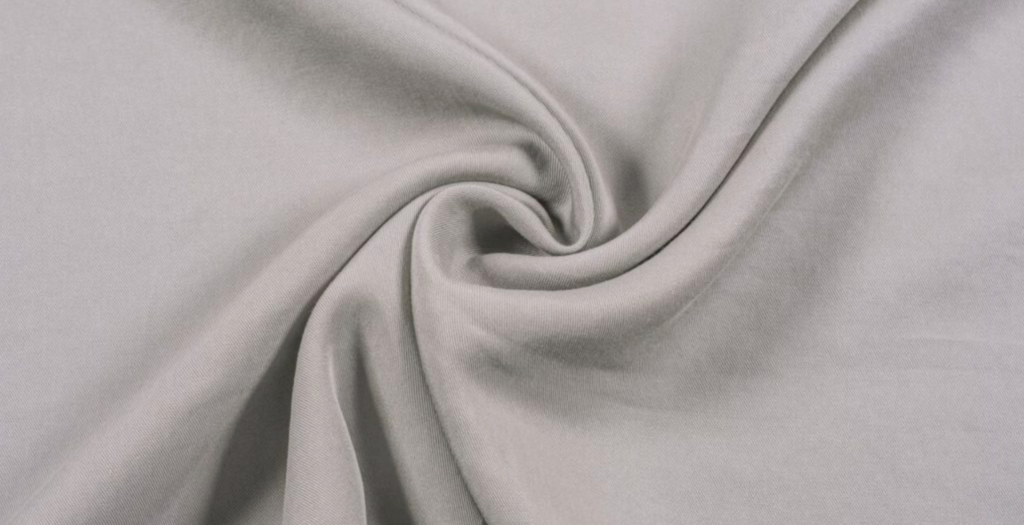
Definition and Characteristics
Tencel comes from wood pulp, mainly eucalyptus trees. The material has earned praise for its smooth texture and ability to let air flow through. These special fibers make clothes that feel good against your skin and help keep you cool in warm weather.
Tencel vs. Other Fabrics
Tencel handles moisture better than cotton and other common fabrics. It uses half the water to make compared to other materials, which helps our planet. This eco-friendly fabric is gentle on sensitive skin and won’t cause allergic reactions. More and more people are choosing Tencel because it’s better for the environment.
Origin and Trademark
The company Lenzing AG owns the Tencel name. Their special way of making the fabric reuses almost all the chemicals in production. This process keeps waste low and helps protect nature.
Tencel Fabric Production Process
Closed-Loop Production Process
Tencel fabric comes from an advanced process that saves almost all used chemicals. The production system is one of the most efficient ways to make clothing material that exists today. Special methods make sure nothing bad goes into our air and water. The technology behind this process helps protect our earth while making quality fabric for many types of clothes.
Raw Materials Sourcing
Trees give us the materials we need to make Tencel. Special forests grow eucalyptus trees that workers carefully harvest to make the fabric. These forests follow strict rules to protect nature and help trees grow back. The companies that gather wood must prove they take good care of the environment.
Benefits of Tencel Fabric
Comfort and Skin Friendliness
Tencel feels super soft and breathes well against your skin. Its ability to move sweat away from your body and be gentle on sensitive skin makes it stand out among other fabrics. I have worked with many fabrics and can say that Tencel gives better comfort than most others. The smooth feel of Tencel makes clothing feel great, even when you wear it all day long.
Environmental Impact
Making Tencel is good for the planet. The process saves almost all the chemicals used and creates much less waste than other fabrics do, and it needs half the water that cotton does to make. Tencel breaks down naturally when thrown away, which makes it perfect for people who care about the earth. This feature has made it very popular with fashion brands that focus on helping the environment.
Durability and Maintenance
Tencel stays strong no matter how many times you wash it. You won’t need to buy new clothes as often, which saves you money in the long run. Washing Tencel is easy – you can use your washing machine or wash it by hand, and it will stay in good shape. The fabric keeps looking fresh and neat for a long time, making it worth every penny you spend on it.
Using Tencel
Fashion and Clothing
Tencel is a soft fabric that many people like to wear. Its smooth feel and ability to let air flow through make it perfect for many types of clothes, from workout gear to fancy dresses. People choose Tencel because it feels good and helps the environment. This makes the fabric very popular with clothing designers who want to make modern, earth-friendly fashion pieces that look great.
Home Items
Tencel works great in items around the house. It keeps sheets, towels, and furniture covers dry and clean, which is perfect for people with allergies or sensitive skin. The fabric is strong and easy to care for, but still looks nice. These qualities make Tencel a top choice for both simple and fancy home decorations.
Challenges and Misconceptions about Tencel
Misconceptions and Marketing Myths
People often think Tencel is hard to care for. Clothing makers have found that Tencel actually holds up well after many washes and keeps its shape nicely. Research shows that it resists wrinkles and stays strong over time. The idea that Tencel needs special care is just not true, according to those who use it regularly.
Cost and Accessibility
Getting Tencel costs more than cotton. Yet many shoppers say the high quality and earth-friendly features make it worth the extra money. The fabric is becoming easier to find in stores. As more clothing brands switch to green materials and better production methods, Tencel is showing up in many more places these days.
Expert Tips for Choosing and Caring for Tencel
Selecting Quality Tencel
Make sure your Tencel is real by looking for tags from Lenzing AG. Quality Tencel comes from properly sourced wood and follows eco-friendly methods.The best Tencel factories save almost all their materials to make new fabric. Good Tencel feels soft and smooth in your hands.
Care Guidelines
Taking care of Tencel is pretty simple. Use cool water and gentle soap when you wash your Tencel clothes in the washing machine. Never use hot water or strong detergents, as these can damage the fabric. Let your Tencel clothes air dry, or use the lowest heat setting on your dryer if you must. Hanging your clothes to dry will help them last much longer.
FAQ
1. What is Tencel fabric made from?
Tencel is made from wood pulp, primarily sourced from sustainably harvested eucalyptus trees through a closed-loop production process.
2. Is Tencel better than cotton?
Yes, Tencel is more moisture-wicking than cotton, uses 50% less water to produce, and is more environmentally sustainable.
3. How do you care for Tencel clothing?
Wash Tencel in cool water with gentle detergent, avoid hot water and harsh chemicals, and air dry or use low heat settings.
4. Why is Tencel considered eco-friendly?
Tencel uses sustainable wood sources, recycles 99% of production chemicals, requires less water than cotton, and is biodegradable.
5. Is Tencel good for sensitive skin?
Yes, Tencel is hypoallergenic, extremely soft, and gentle on sensitive skin due to its smooth fiber structure.
